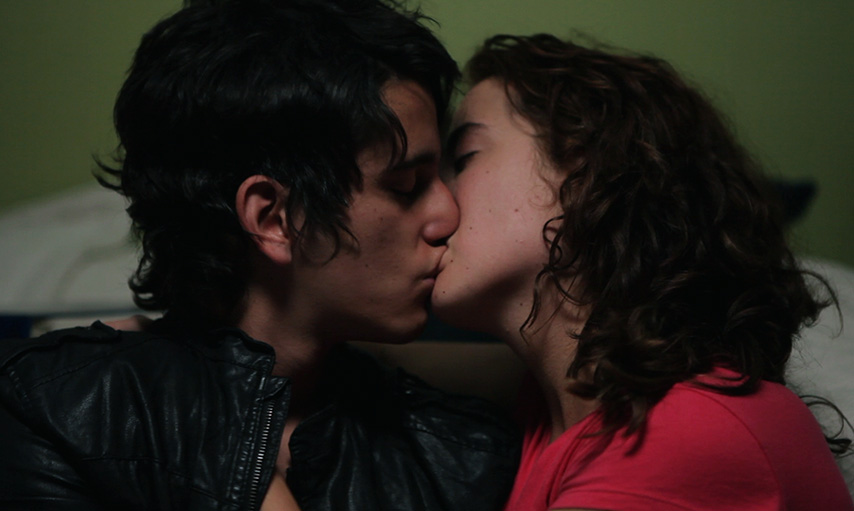Reviews include Civil War, In Flames, and The Greatest Hits.
The rhythm of my life: Lina Rodriguez’s Señoritas
August 21, 2014
By: Kiva Reardon

At first, it’s hard to get a beat on Colombian-born and Toronto-based Lina Rodriguez’s debut Señoritas. The film is comprised of long, exploratory takes, which encourage an observational curiosity in the life and sexual conquests of our listless protagonist, 20-something Bogotá resident Alejandra (María Serrano). It’s never clear when each scene will end and where we’ll go next with Alejandra, but this is precisely the point. In Señoritas, the shape of Alejandra’s life is found in the juxtaposition of moments (in one scene, she masturbates midday; in the next, she’s cutting melons in the kitchen with her mother). Call it portraiture through accumulated exposure.
Over the phone in Toronto, Rodriguez spoke to us about the influence of experimental cinema in Señoritas, her take on John Cassavetes, and why she’s not the “Colombian Lena Dunham.”
Kiva Reardon: When did you start exploring the medium of film?
Lina Rodriguez: I studied film at York, where I did some screenwriting. When I graduated, like everyone, I didn’t have the same access to equipment anymore. So Brad [Dean], my partner [and Señoritas producer] gave me a Super-8 camera. It was a great tool, as it really allowed me to keep practicing—I just kept gathering footage. My methodology started to change from what I’d done in school, and I really focused on exploring ideas that were more loose, the more formal aspects of the image. I became interested in trying to figure out the internal rhythm of images and how to best put them together in a way that was organic to the material. The great thing was that I felt no pressure to make a film. It was about the process of working with images. That’s what I’ve been doing for the last eight years, really working on this intimate and personal process.
You’ve also done installation and performance work. What role did this play in your filmmaking?
In about 2006 or 2007, a friend, who is a performance artist, approached me about doing a piece together. That was a very interesting experience for me, as I’d never really put myself in a situation where I was doing things live in front of people. The performance made me start thinking about the impact of actions, their presents and aftermaths. Things grew from there. My pieces were always very small and personal, so I would just approach galleries about working with them. I did do one Nuit Blanch exhibit where I took Colombian tourism videos and mixed them with violent images from the news. I projected the footage on the walls of a gallery and had a friend DJ all night. It was a bit of a trick: to invite people into the space and distract them enough so they wouldn’t see what’s on the walls. Some Colombian people came and got really mad.
 How did you go about editing Señoritas?
How did you go about editing Señoritas?
I came at it from the experimental point of view of trying to find a film in the footage, but also thinking about body language. That’s where I think all the work with installation and performance was going—how a lot of our inner lives are shown in the way we move. In particular in this film, I wanted to explore how this woman’s search for identity appears in the rhythm of the shots. I also wanted to contrast the public and private life. How you build yourself for yourself, but also for others.
This film has been compared to the work of John Cassavetes. Was he an influence?
It wasn’t like I watched a certain film and wanted to make one like it. It was more a spiritual inspiration. Brad had done a Cassavetes retrospective [at the TIFF Cinematheque] right before we started shooting, so I had just watched many of Cassavetes’ films. I love how alive his cinema is and how many risks he took. It made me want to make something that made me feel alive, and not just make something that I had completely figured out in my head. Also the way Cassavetes made his films—on the side, on the weekends, with friends—this was how I had to do it. I really enjoyed that small production model.
You’ve been called a “Colombian Lena Dunham.” How do you react to that?
It’s almost silly, since the translation of “señoritas” is literally “girls”. But I really don’t watch TV and I’d never seen Girls when I made this movie. There is something about the focus on the daily lives of women that maybe we both share, but I think we’re working in entirely different formats. If anything, the comparison brings more attention to the diversity of representations of women’s lives.
It also feels like these comparisons are reductive. As in, if you talk about young women and sexuality that’s the “Lena Dunham formula.”
I think that just happens when people are up-and-coming. When Matías Piñeiro started getting attention, people called him the “Argentinian Rivette.” But it does annoy me. Can’t we find a different way to talk about cinema than just comparing it to established cinema? I guess it’s a way to make it more accessible.
Can you talk about casting, especially using your mom in the film?
I did a casting call from Toronto then went to Colombia to hold auditions. It was very informal, more like interviews and talking with people. My parents helped me with this; they sat in, did exercises with the actors who were coming in. I was having all these young boys hit on my mom. So she ended up on tape a lot, and when I was reviewing the footage, I realized I had found the person to play the mother.
This also creates a documentary feel in the movie. Was there much improvising?
I had script, narrowed it down to a treatment and really worked from that. The actors only got a barebones synopses and they didn’t really know what was going to happen. The structure of each scene came from what I wrote, so there was that framework, but I wanted the actors to develop relationships between each other. I wanted to try and blur what I wrote and the real relationships the actors built, and use their personal histories. For instance, I knew one guy hated breaking up with girls, so I made his character end things with his girlfriend in the movie.
What are you working on now?
My next film is called This Time Tomorrow. I’m using a similar methodology, but this one is a family drama. I’m heading to Colombia soon to do some casting. Hopefully I’ll find my actors! It’s always a bit scary when you don’t know whom you’re going to work with. But it’s also exciting.
Correction: Brad Deane also edited Señoritas.



